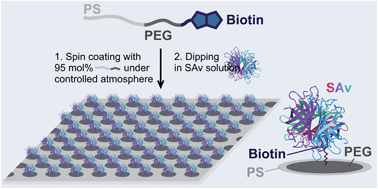Nanoscale organization of proteinsviablock copolymerlithography and non-covalent bioconjugation†
Abstract
Thin films of cylinder-forming biotinylated poly(ethylene glycol)-polystyrene (PEG-b-PS)

* Corresponding authors
a
Radboud University Nijmegen, Institute for Molecules and Materials, Heyendaalseweg 135, Nijmegen, 6525 AJ, The Netherlands
E-mail:
r.nolte@science.ru.nl
Fax: +31 (0)243653393
Tel: +31 (0)243652143
b Institute of Toxicology and Genetics, Karlsruhe Institute of Technology (KIT), Hermann-von-Helmholtz-Platz 1, Eggenstein-Leopoldshafen, 76344, Germany
c Preparative Macromolecular Chemistry, Institut für Technische und Polymerchemie, Karlsruhe Institute of Technology (KIT), Engesserstr. 18, 76128 Karlsruhe, Germany
d IBM Almaden Research Center, 650 Harry Road, San Jose, CA 95120, USA
e
Laboratory for Biomolecular Nanotechnology, MESA+ Institute, University of Twente, PO Box 217, Enschede, 7500 AE, The Netherlands
E-mail:
j.j.l.m.cornelissen@utwente.nl
Fax: +31 (0)534894645
Tel: +31 (0)534894380
Thin films of cylinder-forming biotinylated poly(ethylene glycol)-polystyrene (PEG-b-PS)

 Please wait while we load your content...
Something went wrong. Try again?
Please wait while we load your content...
Something went wrong. Try again?
I. C. Reynhout, G. Delaittre, H. Kim, R. J. M. Nolte and J. J. L. M. Cornelissen, J. Mater. Chem. B, 2013, 1, 3026 DOI: 10.1039/C3TB20411A
To request permission to reproduce material from this article, please go to the Copyright Clearance Center request page.
If you are an author contributing to an RSC publication, you do not need to request permission provided correct acknowledgement is given.
If you are the author of this article, you do not need to request permission to reproduce figures and diagrams provided correct acknowledgement is given. If you want to reproduce the whole article in a third-party publication (excluding your thesis/dissertation for which permission is not required) please go to the Copyright Clearance Center request page.
Read more about how to correctly acknowledge RSC content.
 Fetching data from CrossRef.
Fetching data from CrossRef.
This may take some time to load.
Loading related content
